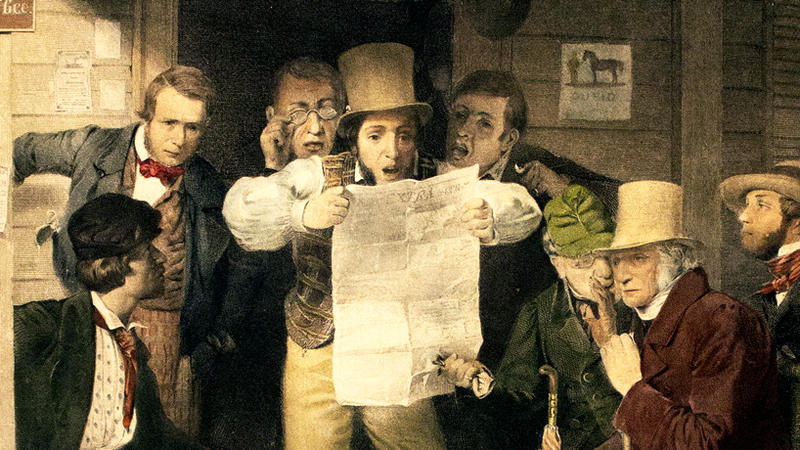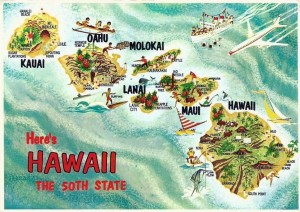Journalism from Early America to the Digital Age… Election Fraud and more…
June 10, 2022 by GuyHeilenman · Leave a Comment
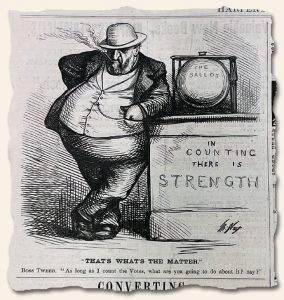 Someone recently brought to my attention an article posted on the website “Brewminate: A Bold Blend of News and Ideas”. While scanning the article I was intrigued by the presence of illustrations of newspapers we have or have previously offered. One in particular which caught my attention was the timely political cartoon by Thomas Nast found in the Oct. 7, 1871 issue of Harper’s Weekly. While a degree of election fraud is (unfortunately) part-and-parcel of the election process, I was inspired to read through the entire article, and in so doing, found it to be quite informative… and wondered if the friends of Rare & Early Newspapers might also find it interesting. Hopefully you will also enjoy reading it:
Someone recently brought to my attention an article posted on the website “Brewminate: A Bold Blend of News and Ideas”. While scanning the article I was intrigued by the presence of illustrations of newspapers we have or have previously offered. One in particular which caught my attention was the timely political cartoon by Thomas Nast found in the Oct. 7, 1871 issue of Harper’s Weekly. While a degree of election fraud is (unfortunately) part-and-parcel of the election process, I was inspired to read through the entire article, and in so doing, found it to be quite informative… and wondered if the friends of Rare & Early Newspapers might also find it interesting. Hopefully you will also enjoy reading it:
“Journalism from Early America to the Digital Age”
From the Library of Congress: “Printing Newspapers 1400-1900: A Brief Survey…”
May 2, 2022 by GuyHeilenman · Leave a Comment
 A friend of Rare & Early Newspapers recently sent us a link to an article posted on the Library of Congress’ blog titled, “Printing Newspapers 1400-1900: A Brief Survey of the Evolution of the Newspaper Printing Press” (written by Joanna Colclough and posted by Malea Walker), which we thought was quite interesting. It begins in part:
A friend of Rare & Early Newspapers recently sent us a link to an article posted on the Library of Congress’ blog titled, “Printing Newspapers 1400-1900: A Brief Survey of the Evolution of the Newspaper Printing Press” (written by Joanna Colclough and posted by Malea Walker), which we thought was quite interesting. It begins in part:
“The printing press has always been a marvel of human invention, and the printing of newspapers occupies a unique course in the history of printing machines. As demands grew for more pages, more news, and faster delivery, newspapers had to achieve greater speeds and higher efficiency.
Newspapers started on Gutenberg presses – individual type pieces arranged backwards by hand, secured in a flat bed, inked by hand, and a great leverage force applied to create the impression. The machine did one part of the job, and newspapers were often printed once a…”
To read the entire post, go to:
Printing Newspapers 1400-1900: A Brief Survey of the Evolution of the Newspaper Printing Press
Sometimes We Miss It – Isidor Louis… 1870’s San Diego…
February 7, 2022 by Laura Heilenman · Leave a Comment
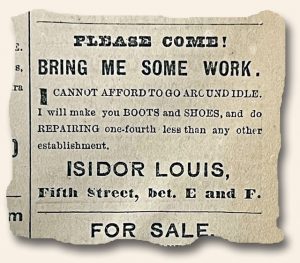 After 47 years as both a collector and reseller of “Rare & Early” newspapers, you can imagine we have unearthed a ton of historical content. However, Every now and then we are reminded that, “Sometimes we miss it”. Today a customer called after purchasing an issue of The San Diego Union to let us know he found a fascinating ad on the front page of his issue. For those who love 19th century California history, there was an early citizen of Jewish descent who had an enormous entrepreneur’s spirit. Isidor Louis had many irons in the fire and was advertising one of his first ventures on the frontpage of the newspaper. Interestingly, his son later became the city editor for the San Diego Sun. Have we piqued your interest? Do a little investigating of Isidor for yourself. Are you wondering how we had an image of the ad after we had already sold the paper? Perhaps we have uncovered others. As a lesson learned, it always pays to read the fine print … in case we missed it.
After 47 years as both a collector and reseller of “Rare & Early” newspapers, you can imagine we have unearthed a ton of historical content. However, Every now and then we are reminded that, “Sometimes we miss it”. Today a customer called after purchasing an issue of The San Diego Union to let us know he found a fascinating ad on the front page of his issue. For those who love 19th century California history, there was an early citizen of Jewish descent who had an enormous entrepreneur’s spirit. Isidor Louis had many irons in the fire and was advertising one of his first ventures on the frontpage of the newspaper. Interestingly, his son later became the city editor for the San Diego Sun. Have we piqued your interest? Do a little investigating of Isidor for yourself. Are you wondering how we had an image of the ad after we had already sold the paper? Perhaps we have uncovered others. As a lesson learned, it always pays to read the fine print … in case we missed it.
Collector Historic Newspapers – A discussion with Tim Hughes…
March 27, 2020 by GuyHeilenman · Leave a Comment
 On March 3, 2020 Mike Safo conducted a podcast with the Tim Hughes, founder of Timothy Hughes Rare & Early Newspapers. His textual intro. to the podcast states:
On March 3, 2020 Mike Safo conducted a podcast with the Tim Hughes, founder of Timothy Hughes Rare & Early Newspapers. His textual intro. to the podcast states:
Joined today by the owner and founder of Rarenewspapers.com, Timothy Hughes. Tim and I talk about our weird passion of collecting newspapers and discuss the current state of collecting and the industry today. We chat about his infamous hometown of Williamsport, Pennsylvania, the home of the Little League World Series. How before the newspaper business Tim was employed by Little League International. He talks about the famous 1980 World Series and how that put the LLWS on the map and golfing with Mike Mussina. Tim takes us back to collecting coins and stamps and how buying a 3-dollar newspaper changed everything. From leaving employment with Little League International to how he acquired over a million newspapers from the 1600a to present day. He tells us which newspaper’s he’ll never sell, which are the most in demand and why the hobby is growing.
The entire, informative podcast can be heard at: Mike Safo’s Interview With Tim Hughes
Mike describes himself as: “Just a regular New York City guy who gets to interview some pretty amazing people… A conversation/hangout podcast with friends, athletes, authors, celebrities, fighters, and the world’s most fascinating people. ‘The greatest podcast ever’ – My Mom”
Headlines of History… The St. Louis Mercantile Library…
November 13, 2017 by GuyHeilenman · Leave a Comment
If you are in the St. Louis area in the near future, you may want to stop by the St. Louis Mercantile Library to view their new exhibit: “Headlines of History: Historic Newspapers of St. Louis and the World Through the Centuries at the St. Louis Mercantile Library Association.” A few related links are as follows:
Posted Interview Regarding the Exhibit
A tribute to Bob Moores…
April 24, 2017 by GuyHeilenman · Leave a Comment
We recently became aware of the passing of Bob Moores, former owner of Gateway Books and a dealer in historic newspapers. Past is Present, the American Antiquarian Society’s blog, has a wonderful related post worth reading:
Tribute to a Great Friend and Book Dealer
Newspaper Museums abound… Looking for input…
January 28, 2016 by GuyHeilenman · Leave a Comment
 Newspapers have been one of the main means of community communication for several centuries. While many newspaper publishers have closed their doors as on-line access has increased, one would still be hard-pressed to find a city without its own printed newspaper. However, as the number of newspaper publishers gradually decrease, the number of newspaper museums appear to be on the rise. Current news may be best viewed within a moment of its occurrence via the internet, news of the past (history) seems to be best viewed first-hand – either by reading a historic newspaper first-hand, or by visiting one of the hundreds of newspaper and print-shop museums. Collecting rare newspapers satisfies the first, but what about the second? The Newseum and the American Antiquarian Society (think Isaiah Thomas) are great place to start, but what about museums with a more local or historical bent? A favorite for some is the relatively new Edes & Gill Print Shop attached to The Old North Church in Boston, but what about others? If you have visited a newspaper museum and/or historic print shop which you found interesting, please share by commenting with the name, location, and a brief mention of what you enjoyed.
Newspapers have been one of the main means of community communication for several centuries. While many newspaper publishers have closed their doors as on-line access has increased, one would still be hard-pressed to find a city without its own printed newspaper. However, as the number of newspaper publishers gradually decrease, the number of newspaper museums appear to be on the rise. Current news may be best viewed within a moment of its occurrence via the internet, news of the past (history) seems to be best viewed first-hand – either by reading a historic newspaper first-hand, or by visiting one of the hundreds of newspaper and print-shop museums. Collecting rare newspapers satisfies the first, but what about the second? The Newseum and the American Antiquarian Society (think Isaiah Thomas) are great place to start, but what about museums with a more local or historical bent? A favorite for some is the relatively new Edes & Gill Print Shop attached to The Old North Church in Boston, but what about others? If you have visited a newspaper museum and/or historic print shop which you found interesting, please share by commenting with the name, location, and a brief mention of what you enjoyed.
Lincoln Assassination Newspapers Atlas…
January 14, 2016 by GuyHeilenman · 2 Comments
Rick Brown been collecting Lincoln assassination newspapers for over 50 years. He has also been a historic newspaper dealer and bought, sold, or brokered in excess of one million historic newspapers. Currently he has in about 200 original Lincoln assassination newspapers – Both Union and confederate. In that same time he been setting aside reprints of the April 15, 1865 New York Herald as he came across  them. In 1992 he self-published “An Atlas of Known April 15, 1865 New York Herald Reprints.” In that work, all pages of 17 different reprint versions were shown. With concentrated efforts in 2015 he contacted a few major institutions and has now discovered 48 different/variants of this edition. His online version of the current atlas that shows all pages of 45 different variants. Also included in this online atlas is background information about the reprints – who published, when, how many pages, etc. The URL for his online Atlas is: http://www.historyreference.
them. In 1992 he self-published “An Atlas of Known April 15, 1865 New York Herald Reprints.” In that work, all pages of 17 different reprint versions were shown. With concentrated efforts in 2015 he contacted a few major institutions and has now discovered 48 different/variants of this edition. His online version of the current atlas that shows all pages of 45 different variants. Also included in this online atlas is background information about the reprints – who published, when, how many pages, etc. The URL for his online Atlas is: http://www.historyreference.
An average of three April 15, 1865 New York Herald’s are listed on eBay EVERY WEEK – that’s over 150 per year. Almost all of these listings claim there’s is an “authentic,” “original,” or “genuine” edition. In the past 15 years he has been conducting weekly searches for “April 15, 1865 New York Herald” on eBay. There have been approximately 2,250 listings for this edition on eBay and ONLY TWICE the listings were actually original editions! Also, since he has been going to estate sales and auctions for over 20 years, he has seen a few hundred of these editions offered – NOT ONE OF THEM were an original!! Over 95% of these reprints were produced over 100 years ago so they LOOK OLD, Looking old does not necessarily mean it is an original. Buyer beware – Collector value for these reprint editions is $10-$20 depending on condition.
If you have a Lincoln-related Web site or know someone that does, please have them add a link to my online atlas.
Rick Brown
http://www.historyreference.
A Nonprofit Organization
Archaeologists uncover secrets of historic Revolutionary War battle site…
November 19, 2015 by GuyHeilenman · Leave a Comment
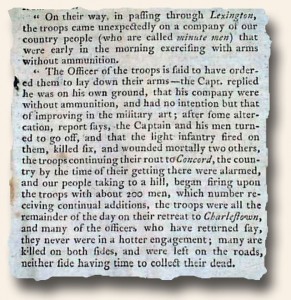 While reports of the events surrounding the skirmish at Lexington & Concord (1775) are few and far between, due to their undisputed importance, authentic newspapers with first-hand accounts are highly prized. A current archaeological effort in and around the area are sure to only increase public interest. The following article brings to light some of the recent finds:
While reports of the events surrounding the skirmish at Lexington & Concord (1775) are few and far between, due to their undisputed importance, authentic newspapers with first-hand accounts are highly prized. A current archaeological effort in and around the area are sure to only increase public interest. The following article brings to light some of the recent finds:
Archaeologists uncover secrets of historic Revolutionary War battle site
Why Hawaii Became the 50th State…
November 12, 2015 by GuyHeilenman · Leave a Comment
Authentic newspapers reporting Hawaii Statehood, especially those from Hawaii, have been sought by collectors for decades. The fascination for “all things Hawaii” appears to have no end in sight. It is with this in mind we bring to you the following guest-post from Francisco Meza:
Why Hawaii Became the 50th State
Hawaii, one of the tiniest states and the only one made up entirely of islands, formally became the 50th state in 1959 (August 21, 1959). But Hawaii’s story starts long before 1959. Polynesians, the earliest inhabitants of these islands, settled here over 1,000 years ago. British explorer Captain James Cook, in 1778, named them the Sandwich Islands. Fortunately, this name didn’t stick. Shortly thereafter, American traders made a beeline for Hawaii’s sandalwood. From July 7, 1898, Hawaiian Islands were an organized incorporated territory of the US.
Why did it Take So Long?
The genuinely interesting question about the Hawaiian Islands becoming a state is the reason it took so long. Over sixty years elapsed from the time Hawaii had become a US possession before it became the 50th state. There were several Hawaiian petitions for statehood in the early part of the 20th century. These petitions were either denied or ignored altogether. Some in the US had felt that the Hawaiian Islands had no natural connection with the remainder of the mainland US. Most obviously, Hawaii wasn’t a contiguous territory. It lay 2,000 miles from the US coast.
American Plantation Owners Resented Paying Import Taxes
The clout of the American plantation owners in Hawaii resulted in its annexation in 1898. The protection of the plantations owners’ financial interests played a huge part too. They were keen on gaining exemption from paying import taxes for the sugar that they shipped to the mainland US. The plantation owners also wanted to safeguard their large land holdings from possible confiscation or annexation under a renewed Hawaiian monarchy.
The US Administration and Citizens Didn’t Favor Annexation of Hawaii
The sentiment in the US about the annexation of the Hawaiian Islands was always strong. The people felt it’d be an imperialistic, unjust, and hence, a most un-American move. Hawaii wasn’t only about sugar. It was an important coaling station for naval vessels, as well as, a potential major harbor. In the 18th and 19th centuries, Great Britain, Russia, and Japan had pressured Hawaii for trade concessions.
The Reasons for the Delay
At the time of annexation (1898), the monarchy had been in existence for just about a century. Originally, the monarchy had leveraged the firepower of the European sailors to consolidate power. An element of brutality was involved too. A high percentage of Hawaii’s Caucasian residents had been there for so long that they considered themselves native. Additionally, numerous Chinese, Portuguese, and Japanese immigrants had come to Hawaii as agricultural laborers and settled down permanently.
Polynesian Hawaiians Wanted to Maintain the Status Quo Because They Considered the Sizable Japanese Populace in Hawaii a Threat to Polynesian Prosperity
The six-decade reluctance to alter Hawaii’s status from a US territory to state lay both within the Hawaiian Islands and the US mainland. In the mainland, it concerned the uncertainty and fear about permitting electoral authority to any one ethnic group. It wasn’t merely ethnically Polynesian versus Caucasian.
In the Hawaiian Islands, some ethnically Polynesian Hawaiians didn’t favor the change to a US state from the existing US territory. This is mainly because, although they were comfortable feeling almost “American” as long as Hawaii was a US territory, they were apprehensive that’d change in case Hawaii became a state. After WWII had ended, the occupation of Japan by the Allies fuelled their fears even more. The Polynesian Hawaiians’ fears originated from a belief that the Japanese populace on the Hawaiian Islands (almost as high as 30 percent) would, in the event of universal franchise that statehood authorized, organize and vote itself into leadership. And Polynesian Hawaiians considered that the Japanese ascent to Hawaii leadership would result in an overall Polynesian descent in Hawaii.
Factors that Favored Hawaii Becoming the 50th State
At the instant of the vote to statehood, almost 90 percent of Hawaii’s populace comprised US citizens. The importance of Hawaii in WWII had secured its identity as 100 percent American both in the minds of the mainlanders as well as the Hawaiians. Additionally, persistent and successful lobbying of Congressional representatives in the initial phase of the contemporary Civil Rights Movement swayed enough members of Congress into accepting the Hawaiian statehood. They were prepared to overlook the islands’ racial makeup.
Why Didn’t Guam or America Samoa Become a State Too?
Almost 18 years after the Pearl Harbor attack, Hawaii, considered a distant frontier of American settlement, was declared a US state in 1959. Since the 1820s, European Americans had settled down in Hawaii and established English as a language. Additionally, an American-style legal system had been introduced early on, and the US dollar was the main currency.
In the case of American Samoa, indigenous Samoans make up almost 90 percent of the population. Hence, it’s unlikely that American Samoa will ever become a US state. In the case of Guam, the indigenous Chamorros make up almost 37 percent of the population. The remainder includes Filipinos, Chinese, Whites, Japanese, Micronesians, Vietnamese, Koreans, and Indians. It’s highly unlikely that Guam will become a US state in the near future.
Summary
After WWII had ended, Hawaiians themselves desired US statehood. Even during the 14-year intervening period before Hawaii was formally conferred statehood, the “49th State” Record Label was immensely popular in the Hawaiian Islands. Eventually, Alaska became the 49th state at the beginning of 1959. Several months later, Hawaii became the 50th.
If you are ever in Hawaii and want to learn about Hawaiian culture, take a few Hawaii Tours that encompass Oahu and the other islands. You’ll learn see where the Hawaiian battles happened, see the beautiful nature, and stop by Pearl Harbor.
© Francisco Meza



